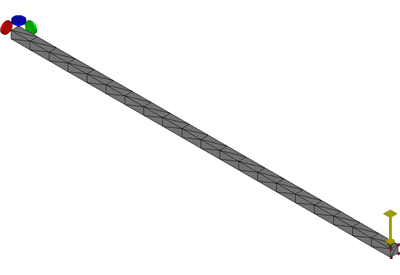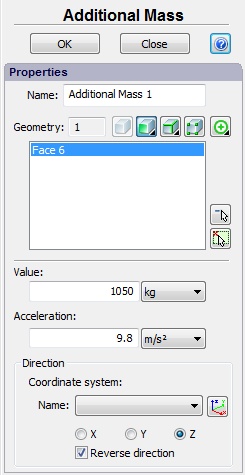 |
AutoFEM Analysis Additional Mass | ||||||
This command allows to determine in the system additional inertial loads emanating from some massive element of the structure as a result of gravity. We assume that we are not interested in the stress behaviour of the massive element per se, but it is necessary to consider its effect on other parts of the system. The dimensionality of the problem being solved (the number of equations) can be significantly reduced.
The Additional Mass can be used in the following studies: static, buckling, frequency, forced oscillations, dynamics.
It should be borne in mind that the use of additional mass, on the whole, considerably burdens the finite element model, since it does not allow to take into account the spatial distribution of mass, just as if a massive body were completely modelled by finite elements.This circumstance should be taken into account, especially in problems of frequency analysis, where the spatial distribution of the mass plays the key role in forming the frequency spectrum of the structure (the values of resonance frequencies and modes). In most cases, replacement of the real mass for its simplified analogue in the frequency analysis is permissible only for the calculation of the first (lowest) own frequency (and not in all cases).


The command "Additional mass" allows you to replace a massive body with its approximate analog and reduce the dimensionality of the task being solved due to this.
To set the additional mass, the following items are used:
Command Line: |
FEMAMASS |
Main Menu: |
AutoFEM | Loads/Restraints | Additional Mass |
Icon: |
|
In the dialogue of properties of the load, one must state facets, ribs or vertices of the body, which contact with the virtual body of the set mass. The mass of the virtual body is uniformly distributed along the user-set part of the structure, i.e. facets, ribs, or vertices.

Also, the setting of the value and unit of measurement of the mass is necessary.
The typical sequence of steps at the setting of the additional mass:
1.Initiate the command “Additional mass” .
2.Select facets, ribs or vertices of the body.
3.Set the value and units of measurement for the mass.
4.Set the value and units of gravitation acceleration.
5.Define the acceleration direction.
6.Complete the command.
See also: Mechanical Loads, Force, Pressure, Hydrostatic Pressure, Centrifugal Force, Gravity, Acceleration, Bearing Load, Torque, Torque at Nodes, Additional Mass, Remote Force, Remote Moment, Remote Mass